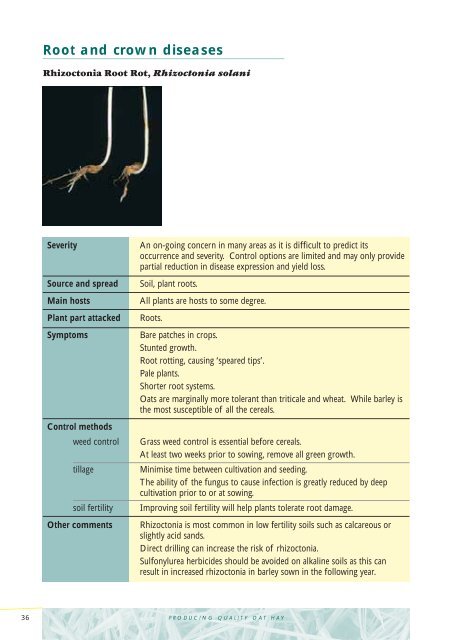You also want an ePaper? Increase the reach of your titles
YUMPU automatically turns print PDFs into web optimized ePapers that Google loves.
Root and crown diseases<br />
Rhizoctonia Root Rot, Rhizoctonia solani<br />
Severity An on-going concern in many areas as it is difficult to predict its<br />
occurrence and severity. Control options are limited and may only provide<br />
partial reduction in disease expression and yield loss.<br />
Source and spread Soil, plant roots.<br />
Main hosts All plants are hosts to some degree.<br />
Plant part attacked Roots.<br />
Symptoms Bare patches in crops.<br />
Stunted growth.<br />
Root rotting, causing ‘speared tips’.<br />
Pale plants.<br />
Shorter root systems.<br />
<strong>Oat</strong>s are marginally more tolerant than triticale and wheat. While barley is<br />
the most susceptible of all the cereals.<br />
Control methods<br />
weed control Grass weed control is essential before cereals.<br />
At least two weeks prior to sowing, remove all green growth.<br />
tillage Minimise time between cultivation and seeding.<br />
The ability of the fungus to cause infection is greatly reduced by deep<br />
cultivation prior to or at sowing.<br />
soil fertility Improving soil fertility will help plants tolerate root damage.<br />
Other comments Rhizoctonia is most common in low fertility soils such as calcareous or<br />
slightly acid sands.<br />
Direct drilling can increase the risk of rhizoctonia.<br />
Sulfonylurea herbicides should be avoided on alkaline soils as this can<br />
result in increased rhizoctonia in barley sown in the following year.<br />
36 PRODUCING QUALITY OAT HAY

















